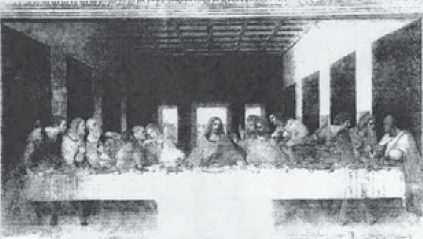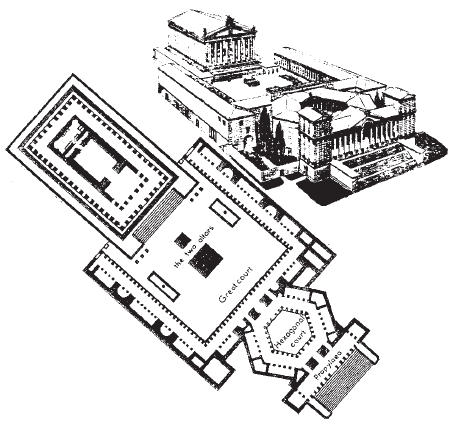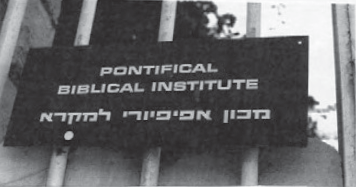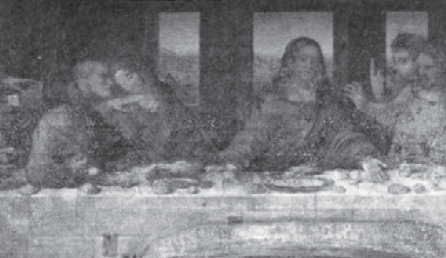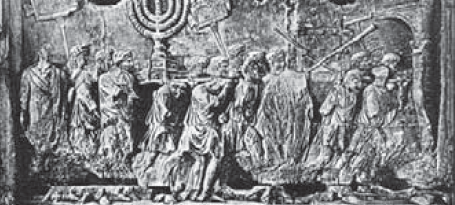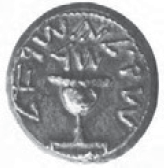|
JERUSALEM: A CHALICE, VANISHED
Questions still swirl about him:
On his last evening of freedom he celebrated the Jewish Passover ceremonial meal (called Seder in Hebrew) with wine and unleavened bread together with his twelve disciples, and the scene has been immortalized by some of the greatest painters of religious art, Leonardo Da Vinci’s The Last Supper being the most famous of them (Fig. 122).
Leonardo was renowned for his scientific knowledge and
theological insights; what his painting shows has been discussed,
debated, and analyzed to this day—deepening, rather than resolving,
the enigmas.
Figure 122
Past, Present, and Future do converge in the two
events, separated by twenty-one centuries; Jerusalem was pivotal to
both, and by their timing, they were linked by biblical prophecies
about the End of Days.
No sooner did he die than his four year-old son and his guardian, Alexander’s brother, were murdered and the quarrelling generals and regional commanders divided between them the main conquered lands:
The Ptolemies, having managed to maneuver Alexander’s body for burial in Egypt, considered themselves his true heirs and, by and large, continued his tolerant attitude toward others’ religions. They established the famed Library of Alexandria, and assigned an Egyptian priest, known as Mane-tho, to write down Egypt’s dynastic history and divine prehistory for the Greeks (archaeology has confirmed what is still known of Manetho’s writings).
That convinced
the Ptolemies that their civilization was a continuation of the
Egyptian one, and they thus considered themselves rightful
successors to the Pharaohs. Greek savants showed particular interest
in the religion and writings of the Jews, so much so that the
Ptolemies arranged for the translation of the Hebrew Bible into
Greek (a translation known as the Septuagint) and allowed the Jews
complete religious freedom of worship in Judea, as well as in their
growing communities in Egypt.
It is
from his three books (which we know of only from fragmented
quotations in the writings of others in antiquity) that the Western
world, of Greece and then Rome, learnt of the Anunnaki and their
coming to Earth, the prediluvial era, the creation of Wise Man, the
Deluge, and what followed. Thus it was from Berossus (as later
confirmed by the discovery and decipherment of the cuneiform
tablets) that the 3600 “Sar” as the “year” of the gods was first
learnt.
As in other instances, historians have searched for geopolitical and economic reasons for the war—ignoring the religious-messianic aspects. It was in the report about the Deluge that the tidbit information was given by Berossus, that Ea/Enki instructed Ziusudra (the Sumerian “Noah”) to,
According to Berossus, the world undergoes periodic
cataclysms, and he related them to the zodiacal Ages, his
contemporary one having begun 1,920 years before the Seleucid Era
(312 b.c.e.); that would have placed the beginning of the Age of the
Ram in 2232 b.c.e.—an Age destined to come soon to an end even if
the full mathematical length is granted to it (2232–2160 = 122
b.c.e.).
The reason for the war to capture
Judea, one must conclude, was the urgency of also preparing the
space-related site in Jerusalem for the Return. It was, we suggest,
the Greek-Seleucid way of preparing for the reappearance of the
gods.
Civil laws
restricted Jewish citizenship in Jerusalem; taxes were raised to
finance the teaching of athletics and wrestling instead of the
Torah; and in the countryside, shrines to Greek deities were being
erected by the authorities and soldiers were sent to enforce worship
in them.
Back in his Syrian capital, Antiochus issued a proclamation requiring worship of Greek gods throughout the kingdom; in Judea, it specifically forbade the observance of the Sabbath and circumcision. In accordance with the decree, the Jerusalem temple was to become a temple to Zeus; and in 167 b.c.e., on the 25th day of the Hebrew month Kislev—equivalent to today’s December 25—an idol, a statue representing Zeus, “The Lord of Heaven,” was set up by Syrian-Greek soldiers in the temple, and the great altar was altered and used for sacrifices to Zeus.
The sacrilege could not
have been greater.
The events, described in the Book of Maccabees (and by subsequent historians), leave no doubt that the fight of the few against a powerful kingdom was guided by a certain timetable: It was imperative to retake Jerusalem, cleanse the temple, and rededicate it to Yahweh by a certain deadline. Managing in 164 b.c.e. to recapture only the Temple Mount, the Maccabees cleansed the Temple, and the sacred flame was rekindled that year; the final victory, leading to full control of Jerusalem and restoration of Jewish independence, took place in 160 b.c.e.
The victory and rededication
of the Temple are still celebrated by Jews as the holiday of
Hanukkah (“rededication”) on the twenty-fifth day of Kislev.
But clarity is lacking because the counts were
enigmatically expressed either in a unit called “time,” or in “weeks
of years,” and even in numbers of days; and it is perhaps only in
respect to the latter that one is told when the count does begin, so
that one could know when it would end. In that one instance, the
count was to begin from the day when “regular offering is abolished
and an appalling abomination is set up” in the Jerusalem temple; we
have established that such an abominable act indeed took place one
day in 167 b.c.e.
The Hebrew calendar, as we have mentioned
earlier, was the calendar begun in Nippur in 3760 b.c.e.—and
according to that calendar, what we call 160 b.c.e. was precisely
the year 3600!
It retells the history of the Jewish
people from the time of the Exodus in time units of Jubilees—the
50-year units decreed by Yahweh at Mount Sinai (see our chapter IX);
it also created a consecutive calendrical historical count that has
since become known as Annu Mundi—“Year of the World” in Latin—that
starts in 3760 b.c.e. Scholars (such as the Rev. R.H. Charles in his
English rendition of the book) converted such “Jubilee of years” and
their “weeks” to an Anno Mundi count.
If we choose just a few of those key historical events, this is what transpires when the “b.c.e.” is converted to “n.c.” (Nippurian Calendar):
The impatient reader will hardly wait to fill in the next entries:
The century and a half that elapsed from the Maccabean freeing of
Jerusalem to the events connected with Jesus after he arrived there
were some of the most turbulent in the history of the ancient world
and of the Jewish People in particular.
The establishment of an independent Jewish state, with Jerusalem as its capital, under the Hashmoneans was a triumphal event in all respects—except one:
Clues were the prophetic parts in the Book of Daniel that spoke of the rise and fall of future kingdoms after Babylon, Persia, and Egypt—kingdoms cryptically called “of the south,” “of the north,” or a seafaring “Kittim”; and kingdoms that shall split off them, fight each other, “plant tabernacles of palaces between the seas”—all future entities that were also cryptically represented by varied animals (a ram, a goat, a lion and so on) whose offspring, called “horns,” will again split apart and fight each other.
Who were those
future nations, and what wars were foretold?
The Jewish leadership split between devout and
by-thebook Pharisees and the more liberal Sadducees, who were more
internationally minded, recognizing the importance of a Jewish diaspora already spread from Egypt to Anatolia to Mesopotamia. In
addition to these two mainstreams, small sects, sometimes organized
in their own communities, sprang up; the best known of them are the Essenes (of the Dead Sea Scrolls fame), who secluded themselves at
Qumran.
On the way there, like Alexander before him, he detoured to Heliopolis (alias Baalbek) and offered sacrifices to Jupiter; it was followed by the building there, atop the earlier colossal stone blocks, of the Roman empire’s greatest temple to Jupiter (Fig. 123).
A commemorative inscription found at the site indicates that the emperor Nero visited the place in a.d. 60, suggesting that the Roman temple was already built by then.
Figure 123
The national and religious turmoil of those days found expression in a proliferation of historic-prophetic writings, such as the Book of Jubilees, the Book of Enoch, the Testaments of the Twelve Patriarchs, and the Assumption of Moses (and several others, all collectively known as the Apocrypha and Pseuda-Epigrapha).
The
common theme in them was a belief that history is cyclical, that all
has been foretold, that the End of Days—a time of turmoil and
upheaval—will mark not just an end of a historic cycle but also the
beginning of a new one, and that the “flipover time” (to use a
modern expression) will be manifest by the coming of the “Anointed
One”—Mashi’ach in Hebrew (translated Chrystos in Greek, and thus
Messiah or Christ in English).
It was recognized in the Bible as an act of consecration to God from the earliest times, but its most memorable instance was when the priest Samuel, custodian of the Ark of the Covenant, summoned David, the son of Jesse, and, proclaiming him king by the grace of God,
Studying every prophecy and every prophetic utterance, the devout in Jerusalem found repeated references to David as God’s Anointed, and a divine vow that it will be of “his seed”—by a descendant of the House of David—that his throne shall be established again in Jerusalem “in days that are to come.”
It is on the “throne of David” that future kings, who must be of the House of David, shall sit in Jerusalem; and when that shall happen, the kings and princes of the Earth shall flock to Jerusalem for justice, peace, and the word of God.
This, God vowed, is “an everlasting promise,” God’s covenant “for all generations.”
The universality of this vow is attested to in:
...and so on.
These are strong words, unmistakable in their messianic covenant
with the House of David, yet they are also full of explosive facets
that virtually dictated the course of events in Jerusalem. Linked to
that was the matter of the Prophet Elijah.
After a period of seclusion at a hiding place near the Jordan River, where he was ordained to become “A Man of God,” he was given a “mantle of haircloth” that held magical powers, and was able to perform miracles in the name of God. His first reported miracle (I Kings Chapter 17) was the making of a spoonful of flour and a little cooking oil last a widow as food for the rest of her lifetime.
He
then resurrected her son, who had died of a virulent illness. During
a contest with the prophets of Ba’al on Mount Carmel, he could
summon a fire from the sky. His was the only biblical instance of an
Israelite revisiting Mount Sinai since the Exodus: when he escaped
for his life from the wrath of Jezebel and the priests of Ba’al, an
Angel of the Lord sheltered him in a cave on Mount Sinai.
The other disciples stayed behind, but even then Elisha persisted on being with Elijah, crossing over with him;
Archaeological excavations at Tell Ghassul (the “Prophet’s Mound”), a site in Jordan that fits the biblical tale’s geography, have uncovered murals that depicted the “whirlwinds” shown in Fig. 103. It is the only site excavated under the auspices of the Vatican.
(My
search for the finds, which covered archaeological museums in Israel
and Jordan and included a visit to the site in Jordan, and
ultimately led to the Jesuit-run Pontifical Biblical Institute in
Jerusalem—Fig. 124—is described in
The Earth Chronicles
Expeditions.)
Figure 124 The tradition was already recorded in the fifth century b.c.e. by the Prophet Malachi—the last biblical Prophet—in his final prophecy. Because tradition held that the Mount Sinai cave where the angel took Elijah was where God had revealed himself to Moses, Elijah has been expected to reappear at the start of the Passover festival, when the Exodus is commemorated.
To this day the Seder, the ceremonial evening meal when the seven-day Passover holiday begins, requires the placement on the meal table of a wine-filled cup for Elijah, to sip from as he arrives; the door is opened to enable him to enter, and a prescribed hymn is recited, expressing the hope that he will soon herald “the Messiah, son of David.”
(As is the case with Christian kids being told that Santa Claus did sneak down the chimney and bring them the gifts they see, so are Jewish kids told that though unseen, Elijah did sneak in and took a tiny sip of wine.)
By custom, “Elijah’s Cup” has been embellished to become an artful goblet, a chalice never used for any purpose other than for the Elijah ritual at the Passover meal.
From 36 to 4 b.c.e.
the king was Herod, descended of Edomite converts to Judaism, who
was the choice of two Roman generals (of Cleopatra fame): Mark
Anthony and Octavian. Herod left a legacy of monumental structures,
including the enhancement of the Temple Mount and the strategic
palace-cum-fortress of Masada at the Dead Sea; he also paid heed to
the governor’s wishes as a de facto vassal of Rome.
Pontius Pilate, arriving in Jerusalem in a.d. 26, made
matters worse by bringing into the city Roman legionnaires with
their pole-mounted signae and coinage, bearing graven images
forbidden in the Temple; Jews showing resistance were pitilessly
sentenced to crucifixion in such numbers that the place of execution
was nicknamed Gulgatha—Place of the Skulls.
When Jesus arrived (with his disciples) this time, the situation was certainly not what was expected, not what the biblical prophecies promised. Devout Jews—as Jesus most certainly was—were beholden to the idea of redemption, of salvation by a Messiah, central to which was the special and everlasting bond between God and the House of David.
It was clearly and most emphatically expressed in the magnificent Psalm 89 (19–29), in which Yahweh, speaking to his faithful followers in a vision, said:
And so it was that
Jesus of Nazareth, now in Jerusalem with his twelve disciples,
determined to take matters into his own hands: if salvation requires
an Anointed One of the House of David, he, Jesus, would be the one!
Then, there and elsewhere in the New Testament, the genealogy of Jesus is given through the generations:
He was qualified, the Gospels assured one and all.
Yet
follow we shall the “official” version, for it, by itself, links the
Jesus events in Jerusalem to all the previous centuries and
millennia, as told heretofore in this book.
Matthew 26: 2, Mark 14: 1, and Luke 22: 1 quote Jesus saying to his disciples as they arrived in Jerusalem:
The three gospels, in the same
chapters, then state that Jesus told his disciples to go to a
certain house, where they would be able to celebrate the Passover
meal with which the holiday begins.
Not saying no, Jesus challenged his closest disciples:
If so, he was asked, where is Elijah, who had to appear first?
This was an audacious statement, the test of which was about to
come: for if Elijah has in fact returned to Earth, “is indeed come,”
thereby fulfilling the prerequisite for the Messiah’s coming—then he
had to show up at the Seder and drink from his cup of wine!
The ceremonial meal is described in Mark, Chapter 14. Conducting the Seder, Jesus took the unleavened bread (now called Matzoh) and made the blessing, and broke it, and gave pieces of it to his disciples.
So, without doubt, the Cup of Elijah was there, but Da Vinci chose not to show it. In this The Last Supper painting, which could only be based on the New Testament passages, Jesus is not holding the crucial cup, and nowhere is there a wine cup on the table!
Instead there is an inexplicable gap to the right of Jesus (Fig. 125), and the disciple to his right is bending sideways as if to allow someone unseen to come between them:
Figure 125
The sentence, to die
on the cross, was inevitable.
IF these were his exact words, he did not mean to say that they were to drink wine turned to blood—a grave transgression of one of the strictest prohibitions of Judaism from the earliest times, “for blood is the soul.”
What he said (or meant to say) was that the wine in this cup, the Cup of Elijah, was a testament, a confirmation of his bloodline. And Da Vinci depicted it convincingly by its disappearance, presumably taken away by the visiting Elijah. The vanished cup has been a favorite subject of authors over the centuries.
The tales became legends:
Or had it, after all, never left Jerusalem?
Though resistance continued elsewhere for another three years, the Jewish Great Revolt was over.
The triumphant Romans were so jubilant that they commemorated the victory with a series of coins that announced to the world Judaea Capta—Judea Captured—and erected a victory archway in Rome depicting the looted Temple’s ritual objects (Fig. 126).
Figure 126
But during each year of independence, Jewish coins were
struck with the legend “Year One,” “Year Two,” etc., “for the
freedom of Zion,” showing fruits of the land as decorative themes.
Inexplicably, the coins of years two and three bore the image of a
chalice (Fig. 127)...
|
